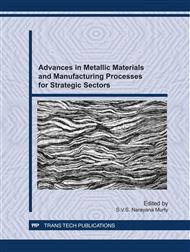p.614
p.620
p.626
p.632
p.638
p.644
p.650
p.656
p.665
Microstructural Characterisation of AA2219 Weldments
Abstract:
Aluminium alloy AA 2219 has been selected for fabrication of both earth storable and cryogenic propellant tanks of launch vehicles due to its high specific strength, compatibility with liquid propellants, good resistance to stress corrosion cracking (SCC), excellent properties at cryogenic temperatures and good fabricability including weldability. Propellant tanks are fabricated by welding sheets in T87 and rings in T851 temper conditions. Microstructural characterization was carried out on the weldments with sheet-sheet and sheet-forge configuration using optical microscopy and electron microscopy with energy dispersive spectroscopy. Microstructure of weld pool had dendritic pattern, typical of weld cast structure. Fine recrystallised grains were observed near fusion line. Heat affected zone on either side of the weld revealed thickened grain boundaries. EDS on these thickened grain boundaries indicated composition of eutectic. Microhardness and tensile strength for both the configurations was evaluated. Fractures surface of tensile tested specimens were examined for fracture morphology and to understand the role of eutectic film in fracture. Presence of the eutectic film along the grain boundaries was explained with the help of liquation mechanism and Al-Cu phase diagram. This paper brings out details of the investigation carried out.
Info:
Periodical:
Pages:
638-643
Citation:
Online since:
January 2012
Keywords:
Price:
Сopyright:
© 2012 Trans Tech Publications Ltd. All Rights Reserved
Share:
Citation:


